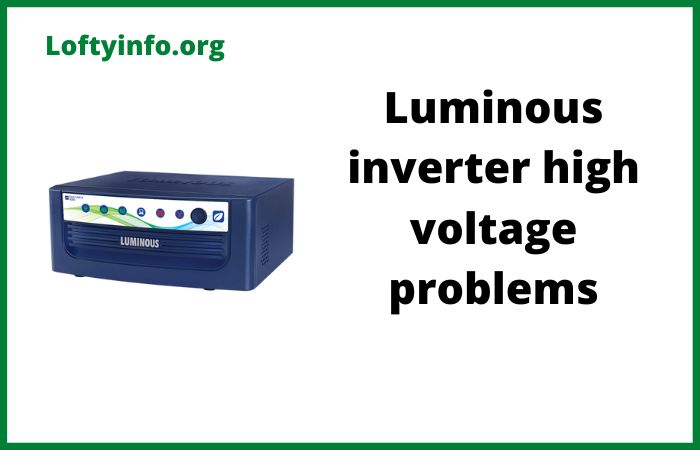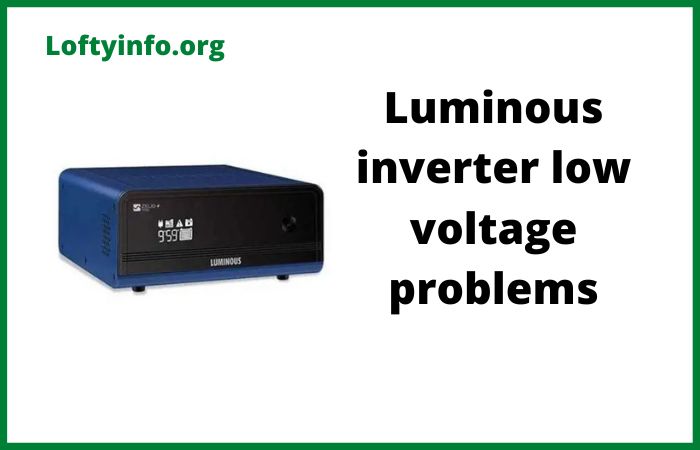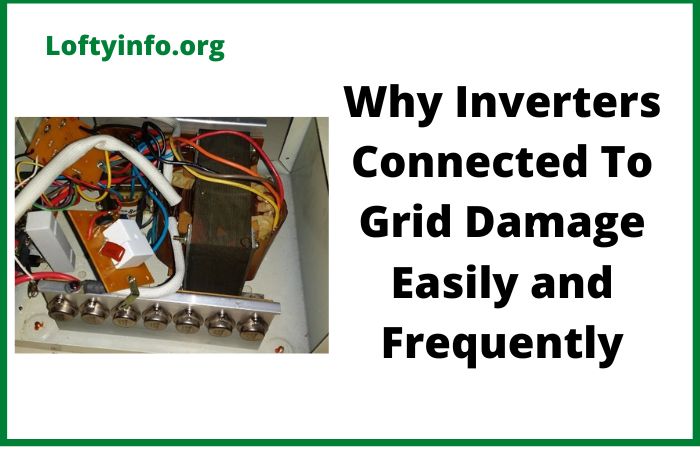Luminous Inverter High Voltage Problems: Causes And Solutions
Luminous inverters have become household names in regions experiencing frequent power outages.
These devices convert DC power from batteries into AC power for home appliances.
While Luminous has built a reputation for reliability, high voltage issues can occasionally disrupt their performance and potentially damage connected devices.
Understanding these problems helps users maintain their inverters effectively and prevent costly equipment damage.
High voltage problems in Luminous inverters typically manifest when the output voltage exceeds the standard range of 220-240V AC.
This excess voltage can cause appliances to malfunction, produce unusual sounds or even suffer permanent damage.
Recognizing the symptoms early and knowing how to address them ensures your inverter continues protecting your home during power cuts.
Causes Of Luminous Inverter High Voltage Problems
1) Faulty voltage sensing mechanism
The voltage sensing circuit in your Luminous inverter monitors incoming mains power and regulates output accordingly.
When this component malfunctions, the inverter cannot accurately detect voltage levels and may output dangerously high voltage to your appliances.
This problem occurs due to aging electronic components on the control board, moisture damage to the sensing circuit or loose connections in the feedback loop.
Power surges during lightning storms can also damage these sensitive components. Manufacturing defects, though rare in Luminous products, may affect the calibration of sensing resistors.
To troubleshoot this issue, first switch off the inverter completely and disconnect it from the mains supply.
Check all wire connections leading to the control board for signs of looseness or corrosion.
Use a multimeter to test the output voltage when the inverter runs on battery mode.
If readings consistently show values above 240V, the sensing circuit likely needs professional attention.
Open the inverter casing after ensuring complete power disconnection.
Visually inspect the control board for burnt components, bulging capacitors or visible damage. Look for moisture traces that might indicate water seepage.
If you spot corroded terminals, clean them gently with an electronic contact cleaner. However, replacing faulty sensing components requires technical expertise.
Contact Luminous authorized service centers for component-level repair or control board replacement.
Attempting complex repairs without proper knowledge may void your warranty and create safety hazards.
2) Battery overcharging leading to voltage spikes
Luminous inverters charge connected batteries to maintain readiness for power outages. When the charging circuit malfunctions, batteries receive excessive charging current that pushes them beyond their rated voltage capacity.
This overcharged state creates voltage spikes that the inverter then transmits to your home wiring.
Several factors cause battery overcharging in Luminous inverters.
A defective charging IC on the main board fails to cut off power when batteries reach full charge. Incorrectly configured charging parameters for your specific battery type can also lead to overcharging.
Some users inadvertently set charging voltage too high during installation. Temperature sensor failures prevent the inverter from adjusting charging rates based on ambient conditions.
Begin troubleshooting by checking your battery voltage directly using a multimeter. For a 12V battery, readings above 14V indicate overcharging, while readings above 28V for 24V systems signal problems.
Examine the battery terminals for excessive heating, corrosion or bulging battery cases indicating overcharge damage.
Access your inverter’s settings menu to verify charging parameters match your battery specifications. Tubular batteries typically require different charging profiles than flat plate batteries.
Consult your battery manual for the correct floating voltage and boost voltage values. Adjust the inverter settings if they deviate from manufacturer recommendations. Check the temperature sensor connection near the battery bank.
This small probe should sit firmly against a battery to provide accurate temperature readings. Clean the sensor tip and ensure proper contact. If overcharging continues despite correct settings, the charging IC on the control board likely needs replacement.
This repair requires trained technicians who can safely handle inverter electronics and properly calibrate the new component.
3) Malfunctioning transformer affecting voltage regulation
The transformer in your Luminous inverter steps up the low DC voltage from batteries to the higher AC voltage needed for household appliances.
A failing transformer cannot maintain stable output voltage and may produce voltage fluctuations or consistently high output.
Transformer problems stem from various sources including overheating due to excessive load or poor ventilation.
Loose windings inside the transformer develop after years of thermal cycling. Short circuits between transformer coils cause irregular voltage output. Physical damage from moisture exposure degrades insulation between windings.
Using the inverter beyond its rated capacity strains the transformer and accelerates wear.
Start diagnosis by listening for unusual sounds from the inverter during operation. A humming or buzzing noise louder than normal suggests transformer issues.
Feel the inverter casing for excessive heat buildup, though avoid touching hot surfaces directly. Monitor output voltage with a multimeter while running different loads.
If voltage rises significantly when you disconnect appliances, the transformer may be failing.
Ensure adequate ventilation around your inverter installation. Remove any objects blocking air vents and clean accumulated dust from cooling fans.
Verify that your total connected load does not exceed the inverter’s rated capacity. Add up the wattage of all devices that might run simultaneously and compare this to your inverter’s specification.
Internal transformer failures require professional intervention.
Opening the inverter reveals the transformer, but testing windings requires specialized equipment like insulation resistance testers and winding analyzers. Service technicians will measure primary and secondary winding resistance and check for inter-turn shorts.
Severely damaged transformers need complete replacement rather than repair. Always use genuine Luminous replacement parts to maintain performance standards and warranty coverage.
4) Deteriorated voltage stabilizer components
Luminous inverters incorporate voltage stabilization circuitry to smooth output and compensate for input fluctuations.
These circuits contain capacitors, inductors and switching components that degrade over time. When stabilizer components fail, the inverter loses its ability to regulate voltage within safe limits.
Component deterioration happens naturally as inverters age, with electrolytic capacitors being particularly vulnerable.
High ambient temperatures accelerate the drying out of capacitor electrolyte. Frequent power cycling stresses stabilizer components.
Using low-quality power strips or extension cords creates additional electrical noise that strains filtering circuits. Voltage transients from nearby heavy machinery or welding equipment can damage stabilizer semiconductors.
Testing begins with careful observation of inverter behavior under different conditions. Note whether high voltage occurs immediately after switching to inverter mode or develops gradually. Check if the problem worsens during hot weather.
Listen for high-pitched whining sounds that indicate capacitor distress.
Use your multimeter to measure output voltage stability over several minutes, watching for gradual drift or sudden jumps.
Inspect the inverter’s internal PCB after proper shutdown and disconnection. Look for capacitors with bulging tops, leaking electrolyte or discoloration around their bases.
These visual signs confirm capacitor failure. Check solder joints on stabilizer components for cracks or cold solder joints that create intermittent connections.
Examine inductors and transformers for signs of overheating like darkened coatings or burnt insulation.
Component-level repair involves desoldering failed parts and installing replacements with identical specifications. This requires soldering skills and knowledge of electronic components.
Capacitors must match not only in capacitance and voltage rating but also in ESR characteristics.
Many users prefer having authorized service centers handle these repairs to ensure proper component selection and installation.
Replacing all aging capacitors during service, even those not yet failed, prevents near-term repeat failures.
5) Software calibration errors causing incorrect voltage output
Modern Luminous inverters use microcontroller-based systems that rely on calibrated software parameters to regulate voltage output.
When these calibration values become corrupted or were incorrectly set initially, the inverter produces voltage outside acceptable ranges despite having functional hardware.
Calibration errors arise from several scenarios.
Firmware updates that fail to complete properly may corrupt stored parameters. Power interruptions during inverter configuration can prevent proper saving of settings.
Some users accidentally change advanced settings while exploring menu options. Electrical surges can corrupt data stored in the inverter’s EEPROM memory.
Manufacturing units occasionally leave the factory with suboptimal calibration that becomes problematic over time.
Begin troubleshooting by accessing your inverter’s display panel or LCD screen. Navigate through the settings menu and note all configured parameters including output voltage setpoint, battery type selection and sensitivity settings.
Compare these values against the specifications in your user manual.
Many Luminous models allow users to adjust output voltage within a small range to accommodate local power standards.
Reset the inverter to factory default settings using the procedure outlined in your manual. This typically involves pressing specific button combinations or accessing a reset option in the configuration menu.
Factory reset restores original calibration values programmed during manufacturing. After resetting, reconfigure basic parameters like battery capacity and type according to your actual installation.
Test output voltage with a reliable multimeter to confirm it falls within the 220-240V range.
If factory reset does not resolve high voltage output, the inverter may require firmware reflashing or advanced recalibration.
This procedure involves connecting the inverter to a computer using specialized software available only to authorized service centers. Technicians use calibration tools to precisely set voltage reference points and tune the control algorithms.
They verify calibration accuracy using calibrated test equipment that traces back to national standards.
Attempting firmware modifications without proper tools and training can permanently damage the inverter’s microcontroller.
Preventive maintenance for voltage stability
Regular maintenance significantly reduces the likelihood of high voltage problems in your Luminous inverter.
Schedule quarterly inspections where you clean dust from vents, check cable connections and verify proper battery water levels for tubular batteries.
Keep the installation area dry and well-ventilated with temperatures below 40 degrees Celsius.
Install a quality voltage stabilizer on the mains input if your area experiences frequent voltage fluctuations. Monitor output voltage monthly using a multimeter to catch developing issues early.
Replace batteries according to manufacturer recommendations as aging batteries can stress inverter charging circuits.
Maintain a log of any unusual behavior to help service technicians diagnose intermittent problems.
Understanding Luminous inverter high voltage problems empowers you to maintain your power backup system effectively.
While some basic troubleshooting steps are user-serviceable, complex electrical repairs should always be handled by qualified technicians.
Prompt attention to voltage irregularities prevents damage to your valuable appliances and extends your inverter’s service life.
high frequency inverters technical specifications data explained
luminous 950 inverter charging problems
Inverter output low voltage problem
How luminous inverter automatic off problem occurs
Fixing amaron inverter overload problems
Why luminous inverter low voltage problems occur
Common Bluetti ac200p problems and solutions explained
Solutions to Common growatt inverter problems
Understanding luminous inverter charging problem
Why you should not charge lithium iron phosphate battery with car alternator
The benefits of solar panels on homes
Causes of Luminous inverter 1050 charging problems
Inverter transformer humming problem






